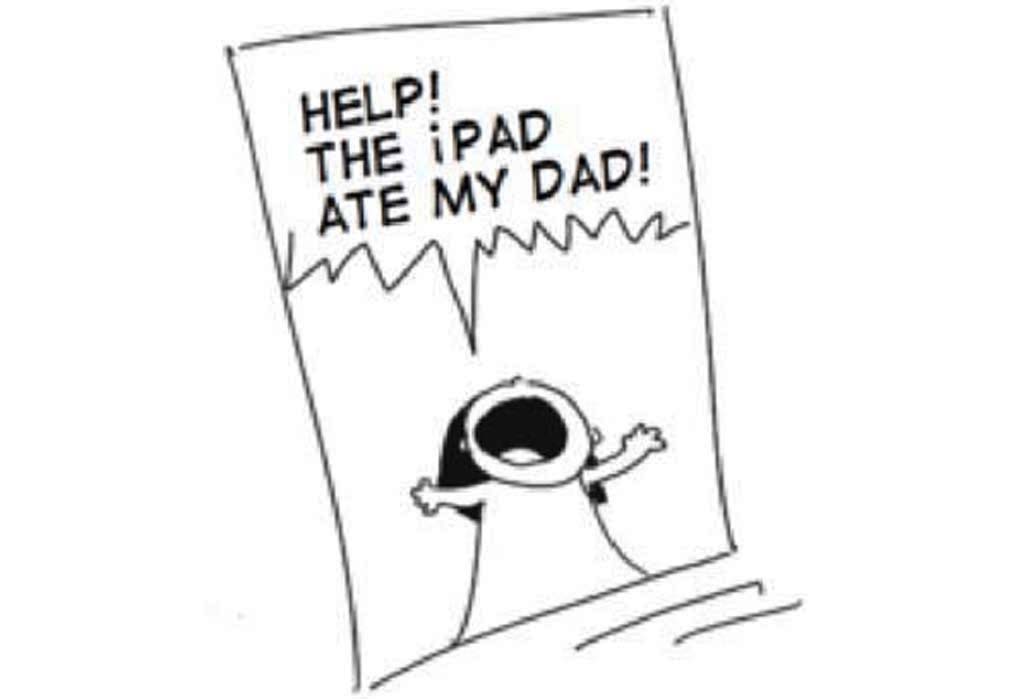Toward the end of 2011, the hubby said that he was going to buy an iPad, but I kept vetoing it. But at the close of 2011, someone gave my mom one. And it all went downhill from there.
Early 2012, the husband started a comic strip line – iDad comics – just for our own enjoyment, satirizing our lives as parents grappling with technology.

In a previous article, I wrote about the highs and lows of kids’ exposure to technology. One question that wasn’t addressed then was how young do we expose our children to technology?
My daughters were 4 and 2 when the iPad arrived. Before that they did not know our smart phones are “toys” as well.
Ahma is quite impressed with the two girls. One time, Shobe, then 2.5 years old, clicked open YouTube, and handed the iPad to Ahma.
“Ahma, type mo dito Ang Pipit (by Pilita Corrales).”
My mom did as told and then said: “Wala e.”
“Ahma, wait lang, loading pa,” Shobe responded.
Ahma was amazed that a toddler could manipulate a gadget with such sophistication. But wait, let’s back up a bit.
Decades of research has shown that brain development in children, especially toddlers, are maximized through physically manipulating objects, engaging all their senses and interacting with a three-dimensional world.
In short, they need to play!
Professor of Education at Lesley University, Cambridge, Mass. (where I went to grad school), Nancy Carlsson-Paige looked into the decline of creativity.
“Researchers who have tracked children’s creativity for 50 years are seeing a significant decrease in creativity among children for the first time, especially younger children from kindergarten through sixth grade,” she notes. “This decline in creativity is thought to be due at least in part to the decline of play.”
When I read Carlsson-Paige’s article last year, the family made a more conscious effort to reduce the children’s gadget time.
Especially after this happened to Tatay when he came home one night.

Summer this year, the husband and I took turns bringing the gadgets away from home or hiding them in our clothes closet. When the kids can’t find the gadgets, they play with the dogs, with a ball, lutu-lutuan (using real cereal on toy plates), camping under our dining table, riding their bikes.
Shobe has taken a liking to washing anything in sight. We often find her in the bathroom washing her dolls’ clothes, a towel, her own underwear in the sink, with the drain plugged tight. The dogs’ bath time is also two hours of bliss for her.
Achi, on the other hand, has been making charts and lists of all kinds for the past couple of months. She lists the names of their stuffed animals, names of her classmates, names of our helpers’ children, games that she likes to play, all our birthdays and our favorite colors.
Lately, I’ve been writing items on our grocery list in alphabetical order in my neatest handwriting so when we go to the supermarket, she ticks off each item we put in the cart. To my horror, she smartly suggested that we shop in the order of the items that appear on the list!
The good news is that the two girls do not mind not having any gadgets to play with. They are simply told Nanay brought the iPad to the office, and they go off to play with something else.
Carlsson-Paige also warns against using screens as digital pacifiers. Yes, screens can distract and entertain them. But what about the long term? It used to be that children are pacified and soothed by parents using age-old techniques of hugging and caressing and soft whispers of lovely reassuring conversation.
Now, we hand them a phone and ask them to quiet down. This does not teach them to be emotionally or socially competent. They are given signals that distress can be handled by outside forces.
Furthermore, the tech world has seen digital addiction among children. It’s the new sugar rush. There may not yet be studies about the digital mania but the reality exists and is a high probability.
Instead of developing inner resilience, we are teaching them to rely on gadgets to get satisfaction or to get over fears.
To help us decide whether or not gadgets are the way to go, we can ask ourselves what we want for our children. Make a comparison. What do they get out of playing Temple Run on the iPad? What if they actually went outside with you and ran around, jumped over rocks, avoided puddles, tried to catch insects?
In answer to my original question, I think parents should put off introducing technology for as long as they can. If, like us, parents are such techies, limit the time children hold on to the gadgets. Even teenagers need to go out and be physical rather than stare at screens the whole day.
Really, our own ingenuity and inventiveness can be the most helpful resource in our children’s learning. — First published in Tulay Fortnightly, Chinese-Filipino Digest 26, no. 3 (July 9-22, 2013): 11
